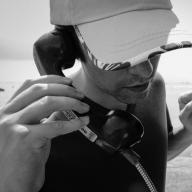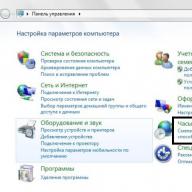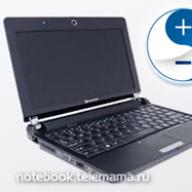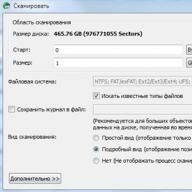Most flash drives are manufactured by manufacturers already formatted in FAT32 format. We start using them without thinking that this file system has serious limitations. One day we need to write a large file with a movie to a USB flash drive, but we can't. What to do? Let's look at this issue from the beginning.
Surely you have a USB flash drive? What filesystem is it formatted on? Don't be embarrassed ... Don't you know? If you don't know, then look like this. Open "My Computer" and select there by clicking the mouse the icon of yours inserted into the USB port of the flash drive. Look in the sidebar. In the screenshot, I even circled the red one on purpose. This flash drive will be in the FAT32 file system. Now I will not dwell on the advantages of NTFS over FAT32. I will only say that if you want to transfer files larger than 4 gigabytes on your flash drive, then NTFS or exFAT should become its file system. It makes sense to leave a USB flash-drive with a volume of less than 4 gigabytes in the FAT32 format.
Easy formatting of USB stick to NTFS
A new or empty flash drive can be simply formatted, since there is no need to be afraid of data loss. They are simply not there. For this you do not need any additional programs, the tools built into Windows are enough. Unfortunately, from the context menu (called by right-clicking on the disk (flash drive) icon), it will not be possible to format the USB flash drive to NTFS. Even if you select the "Format" item, then in the window that appears there will be no formatting option in the NTFS file system.
Therefore, you have to use the format utility launched from the console. Starting with Windows XP SP3, it is included in the OS from Microsoft. To start it, you need to open the console (Win + R and in the window that appears, type the cmd command) and type the format command in it. This command has several keys. In this case, we are interested in the / FS key. That is, the command line should look like:
Format Z: / FS: NTFS
Replace Z with the letter corresponding to your USB flash drive in the system. Be careful not to confuse the letter, otherwise you will format another medium, which can be problematic to recover information from.
The format utility can help you format a USB flash drive not only in the NTFS file system. Starting with Windows XP SP3, Windows supports the exFAT file system, which was originally created specifically for use on portable drives. I will not dwell on its advantages and disadvantages, I will only say that it, like NTFS, allows you to write files larger than 4 gigabytes, which FAT32 cannot. In order to format a USB flash drive in exFAT format, you need to type in the command line:
Format X: / FS: exFAT
After that, just press Enter and the formatting process will begin.
Using the format command, we can format our flash drive in NTFS or exFAT (whichever you prefer), but all files, if any, will be lost. But what if the flash drive is packed with something useful? Then we will have to use a different command.
Convert flash drive from FAT32 to NTFS without data loss
If we do not want to lose data on the flash drive, then we can use the convert.exe utility to convert its file system to NTFS. It is built into Windows XP SP3 and newer. To run it, use the convert command. It should also be typed in the console (see above for launching the console). The convert command can be entered with parameters. It will be better if you familiarize yourself with the capabilities of the utility in advance by entering into the command line:
Convert /?

Help for using this application will appear. Before starting the conversion, I would recommend, just in case, to copy the most difficult-to-recover files from the media to the hard disk. Failures of this process are almost impossible to predict, but it is within our power to minimize losses. In order to convert a USB flash drive, you need to type the command in the console:
Convert Z: / FS: NTFS / NoSecurity / X
Instead of Z, you should indicate the letter of the volume that we are converting. We use the / FS: NTFS key to designate the target file system. / NoSecurity allows us to make files available to all users (in NTFS, file access is regulated much more stricter than in archaic FAT32). The / X switch allows us to forcibly close all connections to the flash drive so that nothing interferes with the process. After typing this command, press Enter.
This utility can be used to convert hard drives without data loss. In order to avoid failures and loss of information, a simple rule should be followed - this process cannot be interrupted. That is, you cannot turn off the power to the computer or remove the media during conversion. Therefore, I advise you to do everything carefully and on a PC equipped with an uninterruptible power supply.
If the computer stops recognizing the USB-drive (in the popular way "flash drive"), and "requires" its formatting, this does not necessarily mean that the data on the flash drive is lost forever.
If there is information on the drive that is important to restore, you can try the options of successful solutions that have already been tested by users.
It may seem obvious, but the first thing to try is to insert the USB stick into a different USB port. Over time, USB ports become dirty and wear out. Therefore, there is a chance that the problem is with the USB port, and not with the flash drive itself.

Updating the driver on a computer
The problem of recognizing a flash drive can also be associated with the system where the flash drive is connected, and not with the drive itself.
To check this option, you need to insert another, obviously working USB drive into the computer port and see if the other flash drive is detected correctly. If not, it may mean that a new driver needs to be loaded on the computer.
To check for a new driver, you need to:
- Open "Computer" (for example, with the keyboard shortcut "Win + E", the "Win" key is located between the left "Ctrl" and "Alt" on the keyboard).

- Right-click the icon for the USB drive that needs to be formatted and click Properties.

- Next, you need to click on the "Hardware" tab and find "General USB Flash Disc USB Device". Click on that device (select it) and click the Properties button at the bottom.

- In the next window that opens, click the "Change settings" button.

- The following pop-up window will appear, where you need to click on the "Driver" tab and click the "Update Driver" button.

- Then you must select the first option "Automatically search for a driver for updated software". And follow the instructions to download the new driver.


Checking errors on a USB flash drive through Windows
Windows can self-detect on USB drives using its built-in software tool.

If Windows can identify the problem, follow the instructions below.
Checking errors with "chkdsk"
You can also check for errors in reading a USB drive through the command line of the operating system by running the "chkdsk" command.

The chkdsk command can also be executed by typing the cmd command in the Run window and clicking OK. After starting the command interpreter window, enter in it: "chkdsk H: / F / R" and press the "Enter" key.


Reference! Instead of the letter "H", you must substitute the letter with which the "problem" flash drive is "signed" in the "Computer". Substituting the letter "/ F" into the command will start fixing file system errors, and the letters "/ R" will start fixing problems with bad sectors.
The "chkdsk" command will check the USB drive for errors and restore the necessary data if possible, displaying a progress report upon completion.

Data recovery from a USB drive with special utilities
There are specialized programs (utilities) developed for scanning USB drives without the help of Windows.
Recuva
One of the leaders in data recovery software is the free utility Recuva. It is easily installed on a computer and quickly and easily performs all the necessary actions.
Recuva features:
- user-friendly interface;
- advanced file scanning;
- recovery from damaged media;
- preview of found files;
- recovering from recent "quick" formatting.
Using Recuva:
- Download the program from a trusted source.

- Run the installation file and follow the instructions of the installer.


- Run the program and click "Next".

- Select "All Files" to display. Click "Next".

- Select "At a specified location" and find the USB drive by clicking the "Browse" button. Click "Next".

- Select "Enable Advanced Analysis". Click "Start".

- After the list of found files appears, tick the necessary ones and click "Restore".

- When the required files are extracted, you can format the USB drive for further work.
Handy Recovery
This utility is paid, but it has a free 30-day trial period.
Using Handy Recovery:

Reference! A convenient feature of Handy Recovery is that red crosses in the program mark files that were previously deleted from a USB-drive, which can also be recovered.
Formatting the USB stick
Perhaps the last step that makes it possible to recover lost files on an "unreadable" USB drive is formatting it.
Important!"By default" Windows carries out a "complete" formatting of storage media. However, in this case it is necessary to carry out a "quick" formatting of the drive. Unlike "full", it does not erase lost files on the media. It only writes a new boot sector and file system table to the USB flash drive, restoring access to it.

Reference! After quick formatting and opening access to the USB-drive in Windows, you can try to extract the files from it using the special utilities described above.
Low-level formatting
If the flash drive malfunctions, the usual, including its full formatting, is not always feasible and does not always solve the problem that has arisen with it.
In this case, formatting at a "low logical level" can "cure" the flash drive. However, after such formatting, it will no longer be possible to recover files from the media.
HDD Low Level Format Tool
Using the program:

A formatted USB drive will be recognized by the operating system as a 0 byte unformatted USB device.
To format a drive in Windows, you can quickly format it as described above.
On a note! Taking into account the serious, including financial costs of restoring lost information, today experts recommend creating backup copies of important data located on any digital media.
Video - How to open a USB flash drive if it requires formatting
All computer users use flash drives from time to time. This is one of the easiest and most convenient ways to move data from one PC to another. Flash drives have gained such distribution due to their speed of operation and versatility. But they also have their own serious drawbacks. Surely every user knows cases when the flash drive does not open, asks to format. In this regard, many have the question of how to recover an external hard drive without formatting.
The main causes of the problem
If the flash drive does not open, it writes to format it is not a cause for concern. The file system is slightly damaged and the computer cannot read it, but this does not mean that the data has been lost.
If you hover over the USB flash drive and open the properties, the system will show that it is empty. · "Busy" - 0 bytes. · "Free" - 0 bytes.

This indicates that the flash drive does not work and there are errors in it, or the data has been damaged, for example, if the device was removed incorrectly.
Always use a secure disconnect device to avoid problems with your flash drive.
How do I recover the data I need?
The simplest solution to the problem is to format the external hard drive. Then it will work again.
If the flash drive asks to format, how to recover the data? Many convenient programs have been invented specifically for this. One such program [email protected] File Recovery.
The hard drive asks for formatting, how to recover data using [email protected] File Recovery?
- We launch the utility.
- On the left we find our USB flash drive.
- Click "Super Scan" in the top menu.
- Next, we should open a window with all the necessary settings. In this window, select the file system of our external hard drive.
If you do not know which system was used, you can mark several at once.Click "Scan". Now we are waiting for the utility to complete the scan. It usually takes about ten minutes. Then "Super Scan" will appear on the left, click it. In the field on the right you can find all the data that was on the flash drive. Select what you would like to recover, and click "Recover". Select the folder to save. The data is restored.
If there was a lot of data on the external hard drive, and you do not know exactly what you need, you can restore everything at once. In addition, after scanning, you can use the search for the found data.
One of the most unpleasant situations that can arise with a USB flash drive is that you connect it to a computer to copy important data, and the system requires it to be formatted. It would seem like a hopeless situation, but there is still a fairly simple way to regain access to files stored on a USB flash drive.
To recover files from a flash drive, we will turn to the help of a third-party program [email protected] File Recovery , which allows you to return most of the deleted information.
Note! Although [email protected] File Recovery allows you to recover files from already formatted flash drives, do not start formatting on a problem drive until the necessary files are restored.
Now you need to start scanning. For this in [email protected] File Recovery has two modes:
1. QuickScan - fast mode. Allows you to recover files faster, however, some part may be overlooked.
2. SuperScan - a thorough scan mode, which, accordingly, will take much longer. When using this mode, you have a much higher chance that all information from the flash drive will be successfully recovered.
Naturally, choose the SuperScan item. An additional window will open displaying the scanning parameters. If you need to recover all files, then select the item "All (Slow)" .

If you want to reduce the scanning time, you can specify the file extensions that the program will look for on the drive. To do this, select the item "Some" and mark the required file types.

Click the button "Start" to start the scanning process. A status bar will be displayed at the bottom of the window showing the progress of the restore.

Once the scan is complete, a folder will appear on the left side of the program called "SuperScan" , which will contain all found file types. Select them and specify the location on your computer where they will be saved.
This completes the recovery process. You can find files from the flash drive in the specified folder. From now on, you can calmly.
As you know, external storage is a portable and easy-to-use device. With it, you can transfer files anywhere, and you don't need to worry about the workload of your computer. However, each coin has two sides, which means that in some cases, data loss is inevitable.
A damaged USB flash drive is one of the most common problems faced by Windows users. In this situation, you need to format it to work properly. If you have important files, you will have to use other methods. Fortunately, we can offer you several ways to solve the problem.
There are quite a few reasons for damage to a storage device.
Below is a list of the main ones:
- Virus infection (contributes to hiding files and folders, turning them into shortcuts or losing access to an external drive).
- Disconnect the device from the computer without ejecting or ejecting in safe mode.
- Resetting external storage.
- Accidental deletion of some system files (leads to the fact that the flash drive becomes unreadable).
- The device is not recognized by the computer for an unknown reason.

One of the reasons for the malfunction of the flash drive is a virus infection
However, if the error has already occurred, we will show you how to fix a damaged drive without formatting.
How to fix a USB flash drive without data loss using the command line
The command line is the simplest and most affordable repair option without the need for formatting. This built-in Windows tool also allows you to fix a damaged SD card. Let's see how it works.

This operation will force Windows to check and fix the file system on the flash drive. If the recovery process goes well, then in the program window you will see "Windows has made corrections to the file system." This indicates that the damaged USB drive has been successfully repaired and can be accessed again.
How to fix a USB flash drive using a recovery tool
If the above method doesn't work then follow these steps:

Video - How to restore a USB flash drive using standard Windows tools
How to fix a damaged USB drive with EaseUS USB Repair Tool
If all of the above solutions did not help, then try using a dedicated EaseUS file recovery program. However, with its help, you can access files, but not fix the USB flash drive itself. You will have to format it to reuse it. The program recovers USB data in almost all cases of loss of access.
Important! Unfortunately, it is paid because the trial version only allows you to scan the drive and identify files available for recovery.
If you are not ready to pay, then in any case, verification will not hurt:

Recovering a USB flash drive before formatting using iBoysoft Data Recovery
iBoysoft Data Recovery is a safe and easy-to-use data recovery software. It helps to get them back both from a faulty USB drive, as well as an SD card, hard drive, memory card, etc.
Important! In addition, iBoysoft Data Recovery can reanimate files written on a faulty Raw disk, as well as those saved on a deleted or lost partition.
To recover important data, follow three simple steps:

After copying files from a damaged flash drive, you can format it and use it again.
If all else fails, then try these simple tricks:
- to find and destroy all possible viruses on the flash drive, run an anti-virus scan;
- restart your computer and see if it can read the device;
- connect it to a different operating system or USB port.

The following useful tricks will help you avoid the above problems:
- set a password. Despite all the advantages of a USB drive in terms of storing and transferring data between computers, it can be accessed by unauthorized users. Therefore, to keep your personal or business files safe at all times, encrypt the USB flash drive. At least, without a password, no one will be able to view and edit your data;
- store your portable OS. If the computer crashed and does not boot in the usual way, then a USB flash drive with a portable OS installed will help temporarily load it and find a solution to the problem;
- save the required programs. Not all computers you use have the software you need. Therefore, save them to a USB flash drive and freely install anytime, anywhere.
Video - How to recover a USB flash drive without formatting using the program




